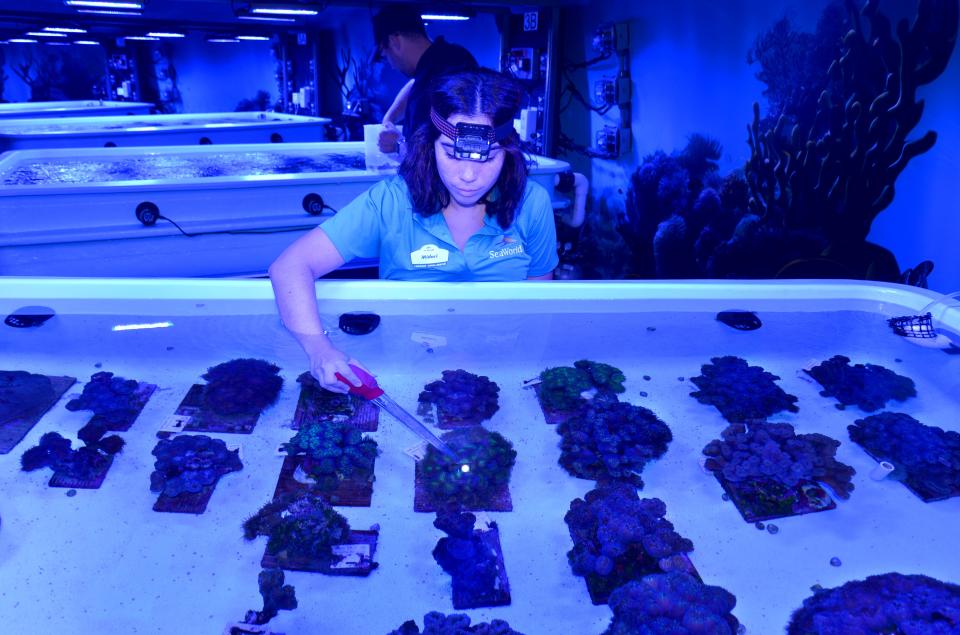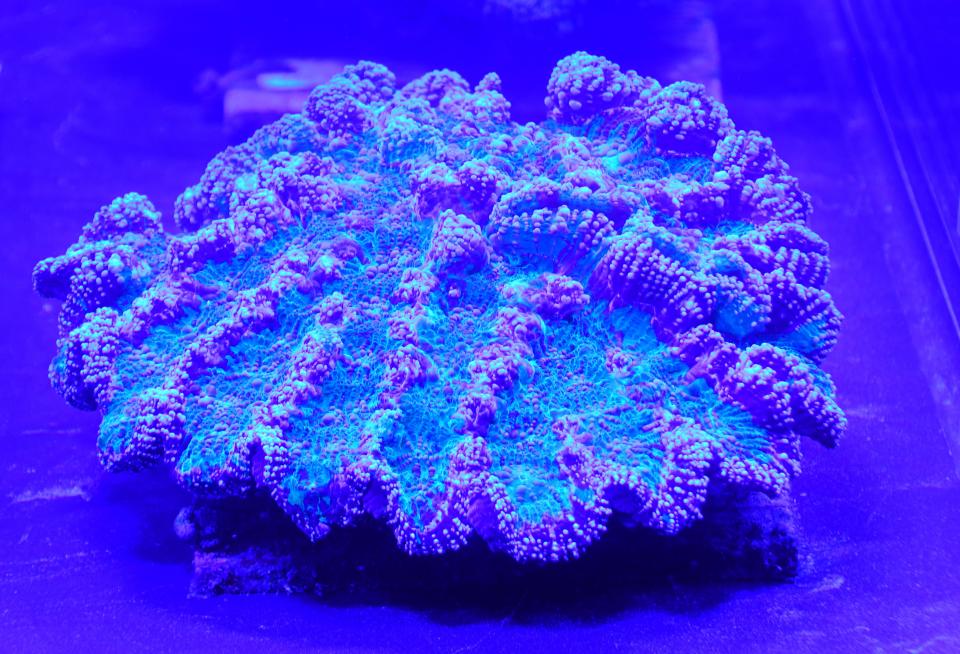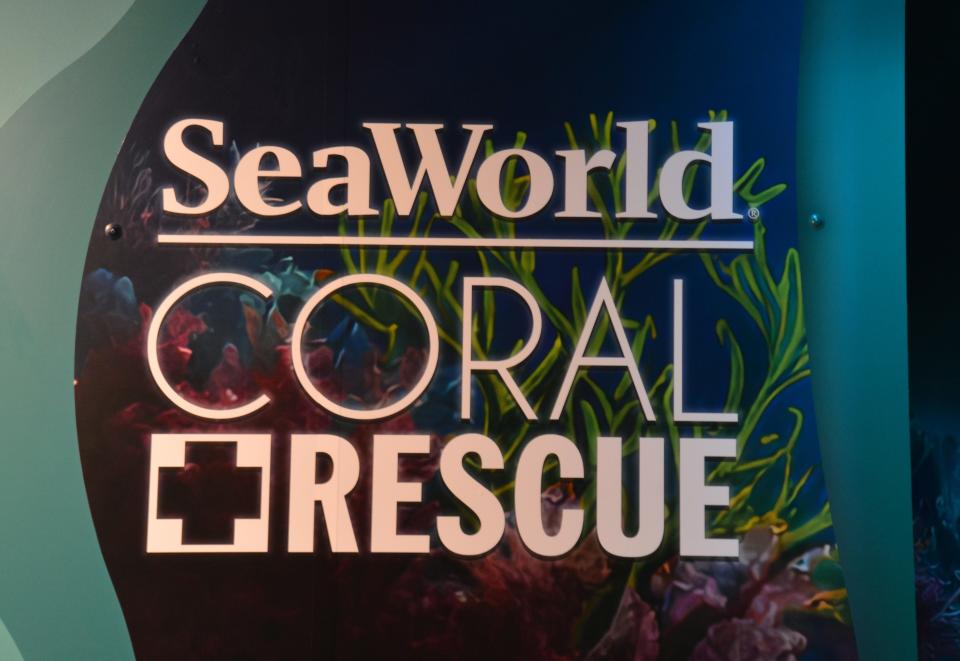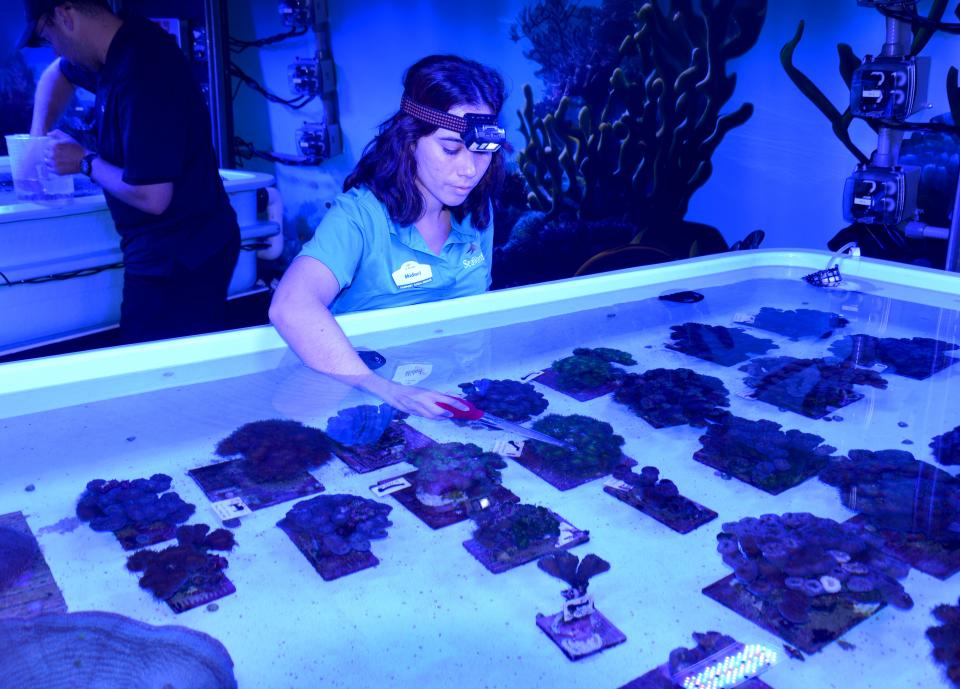SeaWorld opens new coral center to help save the endangered marine creatures
Think of it as a seed bank to store the genes of Florida's most imperiled corals until safer times along the state's dying reefs.
SeaWorld Orlando's new Coral Rescue Center, unveiled Friday, aims to preserve Florida corals that are collapsing under a mysterious disease, which in less than a decade has decimated coral from Martin County to the Lower Keys.
No one knows for sure what causes the disease, just that it's a stone-cold killer.
"The Florida Reef Tract is currently under siege by a very lethal disease called Stony Coral Tissue Loss Disease," Jim Kinsler, zoological curator at SeaWorld Orlando and manager of the Florida Coral Rescue Center, told FLORIDA TODAY Thursday during a behind-the scenes tour of the new facility. "The disease, once a coral colony contracts it, is almost 100% fatal to that colony."
Corals are diverse, living marine invertebrates that lack a spine but their external skeletons build reefs that provide the ecological scaffolding for more species than any other marine habitat, rivaling rainforests in diversity of life.
Countless marine creatures rely on coral reefs to hide, feed and breed. Beyond coral's obvious role in the seafood chain, scientists suspect compounds in sponges and other organisms that grow on coral reefs could yield cures for cancer and other human diseases.
But many reefs worldwide have already been severely damaged by a growing litany of threats, including pollution, overfishing, global warming and more recently — Stony Coral Tissue Loss Disease.

More: More man-made reef splashes down in Brevard
The disease is not thought to have spread as far north as Brevard County yet and the threat here remains uncertain. Biologists hope the Oculina deep-sea coral species that grows offshore of the Space Coast continues to show some resistance to the disease.
But at least two dozen other coral species in Florida are either highly, intermediately or presumed susceptible to the disease. That's why, conservation biologists say, SeaWorld's new space to store the most resilient coral genetics is so vital for long-term survival of a key bedrock of the marine and human food web. They hope the coral offspring spawned at SeaWorld can fend off current and future diseases when transplanted back in the wild and teach us why our future is intimately linked to these lowly, stunningly colorful creatures.
“By raising awareness about the importance of corals and their role in the environment, we hope to ignite apassion for conservation in our visitors, empowering them to become ambassadors for the protection and preservation of Florida’s corals,” Kinsler said in a statement before Friday's event.
Dignitaries at Friday's grand opening included members from Florida's conservation and rescue communities and local and, state and federal lawmakers. The opening of SeaWorld's new coral center marks a milestone in the Florida and SeaWorld's commitment save the state's reefs, conservation biologists say. SeaWorld calls the center a "vital hub" for coral preservation and education, building on the success of the Florida Coral Rescue Center, adding another holding facility for vulnerable corals.
The 3,750-gallon facility at SeaWorld houses 350 coral colonies and 18 species of at-risk coral, several listed as threatened under the U.S. Endangered Species Act.
Visitors can interact with coral biologists working with the “at risk" Florida reefs.
Threatened corals were selected and transferred to SeaWorld from the Florida Coral Rescue Center (FCRC) –— the largest coral nursery in the country, a 2,000-square-foot facility in an Orlando industrial park off South Orange Blossom Trail. The goal is to save the most disease-resistant coral genes. SeaWorld's new center adds more space beyond FCRC's for rescuers to try to keep pace, or hopefully outpace, Stony Coral Tissue Loss Disease lightning-fast scourge through Florida's offshore reefs. The goal is to return the stronger coral to Florida reefs as part of state and national restoration efforts.
SeaWorld's new coral center has advanced aquarium lighting, filtration systems, a working laboratory, and rows of water tanks where the rescued coral live. It is located adjacent to SeaWorld's Manatee and Turtle Rescue habitat. The coral comes from more than rescue sites from Palm Beach throughout the Keys.
Experienced coral biologists at SeaWorld meticulously monitor water chemistry, flow, filtration and lighting to ensure the corals thrive. They hope to preserve a natural environment by introducing "reef cleaners" such as fish, snails, crabs and sea urchins. These "grazers" play a crucial role in cleaning algae from the corals and their surroundings, enabling coral growth. To supplement their nutrient requirements, the SeaWorld biologists provide the corals with supplemental nutrients that they process for energy.
New federal money for Florida corals
SeaWorld worked with Sen. Marco Rubio, R-Florida, and Darren Soto, D-Kissimmee, to pass the Resorting Resilient Reefs Act. The bill continues to support the efforts and expand research and resiliency programs.
The bill increases authorizations for the National Oceanic and Atmospheric Administration’s (NOAA) Coral Reef Program from $16 million to $45 million annually. It also authorizes a state block grant program for $12 million yearly for state efforts to manage and restore coral reefs, and $4.5 million annually for Pacific and Atlantic coral reef cooperative institutes.
“The Florida coral reef is in trouble which poses both an ecological and economic threat to the state of Florida and the country. It’s the largest coral reef ecosystem in the continental United States and vital to maintaining healthy oceans. It also supports over 71,000 jobs and generates over $6.3 billion in tourism revenue every year,” Darren Soto, D-Kissimmee, said in a statement before Friday's event.
The nonprofit Fish & Wildlife Foundation of Florida also is the partner of the state's coral rescue center initiative.
“Corals are the rainforests of the ocean,” Andrew Walker, Fish & Wildlife Foundation of Florida President & CEO, said before Friday's event. “In addition to providing a home for a quarter of all marine life, corals buffer our coastline from damaging storms and fuel our state’s economy. We’re grateful to SeaWorld for providing a space for these rescued corals to thrive and for the public to learn more about our partnership to restore Florida’s Coral Reef.”
The Florida Coral Rescue Center (FCRC) was established for gene banking and care of corals rescued from the Florida Reef Tract in areas not yet affected by Stony Coral Tissue Loss Disease, with the first rescued corals arriving there in March 2020.
What is Stony Coral Tissue Loss Disease?
Biologists say Stony Coral Tissue Loss Disease is unprecedented and has been killing more than 20 Caribbean coral species and coral on Florida’s reefs since 2014. A study last year by NOAA and University of Miami of the 350-mile long Florida Reef tract, from the Dry Tortugas to St. Lucie County, found 70% of the reef is eroding faster than it's growing.

The disease began near Miami, Florida, and has since spread through the northern extent of Florida's reef tract in Martin County, south through the Florida Keys, west into the Marquesas, according to Florida Fish and Wildlife Conservation Commission.
The precise cause is unknown.
SeaWorld small demonstration project will enable the amusement park to bring the story of Florida’s dynamic reefs to millions of visitors annually, park officials say, educating and informing them about Stony Coral Tissue Loss Disease and other threats to Florida coral.
"The goal of the facility is not only to preserve these corals, to preserve their genetics," Kinsler said. "but also to to be able to reproduce these corals and return their offspring back to the Florida Reef Tract, so we can continue to preserve these species and these genotypes."
For information, visit SeaWorldOrlando.com.
Florida Department of Environmental Protection maintains a coral rescue dashboard.
Jim Waymer is an environment reporter at FLORIDA TODAY. Contact Waymer at 321-261-5903 or jwaymer@floridatoday.com. Or find him on Twitter: @JWayEnviro or on Facebook: www.facebook.com/jim.waymer


This article originally appeared on Florida Today: SeaWorld aims to save Florida's reefs by storing corals' best genes

